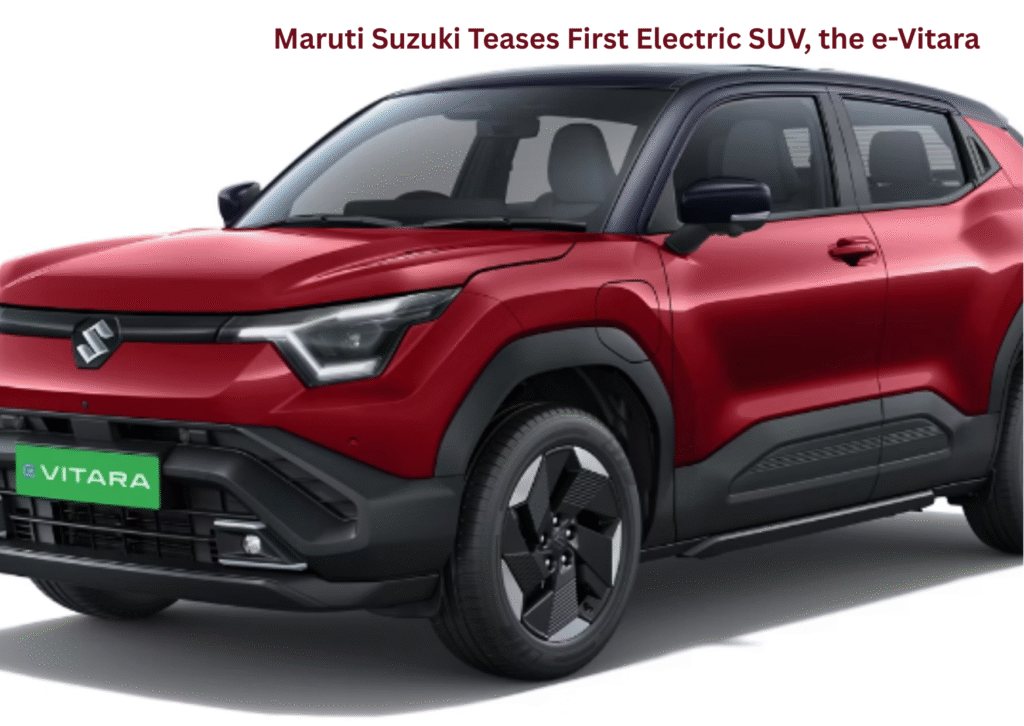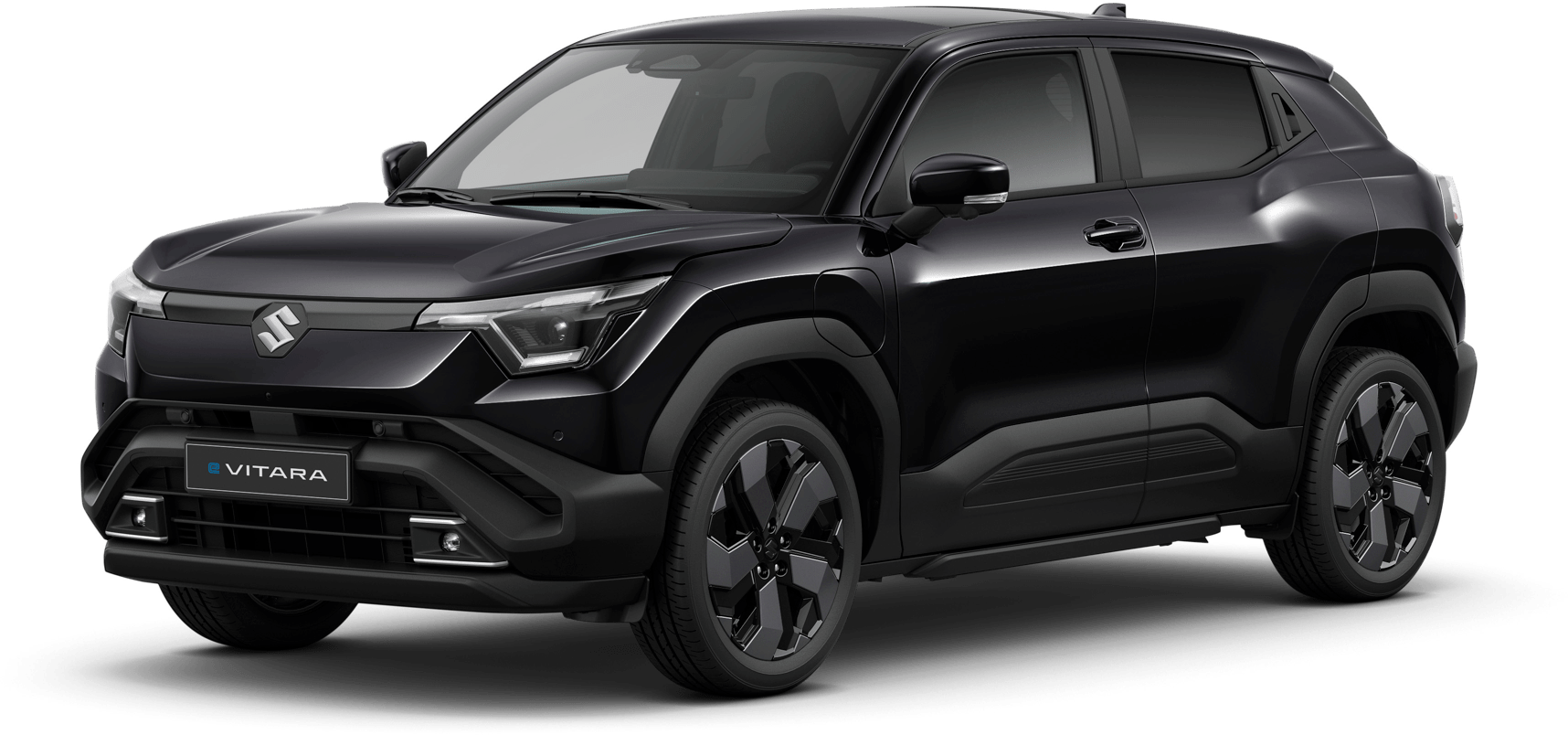The Maruti Suzuki teases the first electric SUV, the e-Vitara from Maruti in India, and it’s more than just another launch—it’s the company’s entry ticket into the future of mobility. For decades, Maruti Suzuki has been the face of affordable, reliable cars in India, but now the brand is gearing up for an even bigger stage. The e-Vitara isn’t just about electrification; it’s about showing the world that India can build EVs that look rugged, feel modern, and travel more than 500 km on a single charge.
Table of Contents
The Big Moment for Maruti
Think about it: India’s most trusted carmaker stepping into electric mobility. It feels like a full-circle moment. For years, Maruti focused on petrol-first strategies, even as rivals like Tata, MG, and Hyundai pushed ahead in the EV space. Many critics said Maruti was late to the party. But with the Maruti e-Vitara—the first electric car from Maruti in India—the company seems ready to prove that sometimes it pays to take your time.
This SUV will be manufactured in India and sold both here and abroad. That’s a crucial point. It means the e-Vitara isn’t just built for Indian buyers—it’s meant to compete head-to-head in Europe and other global markets.
A Trail of Updates that Built the Hype
The story of the e-Vitara has unfolded like a movie trailer, with each announcement adding to the suspense.
In April 2025, we heard that the India launch was delayed till September, which disappointed many. Then came a string of updates that changed the mood completely.
By June 2025, the SUV was already on sale in the UK, priced between £29,999 and £37,799 (roughly Rs 35–44 lakh). That was followed by a big claim in July—a WLTP-certified range of 426 km. For a Maruti, this was unheard of.
The excitement peaked in August 2025 when production began at the Hansalpur plant in Gujarat. The fact that Prime Minister Narendra Modi personally flagged off the first export unit made headlines across the country.
In September, Maruti dropped two more bombshells. First, they announced that over 2,900 units had already been exported to countries like Germany, Norway, and the UK. And then came the Euro NCAP crash test results: a 4-star safety rating, with 77% adult and 85% child protection scores. For a company often criticized for weak safety ratings, this was a turning point.
Step by step, Maruti built a story of the Vitara that felt global, aspirational, and proudly Indian.
What the e-Vitara Looks and Feels Like
First impressions? Rugged. The SUV has that chunky stance that Indian buyers love, paired with modern styling elements that make it look more futuristic than the Grand Vitara. The dashboard is digital and clean, with a big infotainment screen at the center. Maruti hasn’t gone overboard with gimmicks—it’s modern, yes, but still familiar enough to feel like a Maruti. That balance will matter a lot when first-time EV buyers step in.
Range and Performance

The Maruti e-Vitara is the first electric car from Maruti in India to claim a 500+ km range. That figure alone will draw attention in a market where range anxiety is still real. Of course, the official WLTP figure from the UK stands at 426 km, which means real-world numbers in India will likely hover around 380–400 km. Still, that’s enough to cover city commutes and weekend getaways without nervous glances at the battery percentage.
Another interesting choice is the front-wheel-drive layout. Some enthusiasts might complain about the lack of all-wheel drive, but Maruti’s decision makes sense. FWD is lighter, more efficient, and easier to maintain—things Indian buyers will value more than raw off-road ability.
How It’s Positioned Globally
Maruti hasn’t just built an SUV for India; it’s built one for the world. The UK launch showed that clearly. By pricing the e-Vitara lower than many European rivals, Maruti positioned it as an affordable yet capable EV. The exports to over a dozen countries in Europe prove that this isn’t just a token global release—it’s a serious attempt to carve out market share.
At home, the stakes are even higher. If Maruti can price the e-Vitara somewhere in the Rs 20–25 lakh bracket, it could immediately undercut rivals like the MG ZS EV and Hyundai Kona. Combine that with Maruti’s after-sales service and trust factor, and you have the recipe for a bestseller.
Quick Stats at a Glance
| Year | Stat | Source |
| 2025 | 4-star Euro NCAP safety rating | Euro NCAP |
| 2025 | 2,900+ units exported to Europe | Maruti Suzuki |
| 2025 | WLTP range of 426 km in UK | WLTP |
| 2025 | UK launch price: £29,999–£37,799 | Maruti UK |
These aren’t promises; these are milestones already achieved.
Strengths and Weak Spots: A Grape-Style Look
| Feature | Benefits | Pros | Cons |
| 500+ km claimed range | Long trips possible | Competitive with rivals | Real-world figure lower |
| FWD setup | Practical and affordable | Good for city/highways | No AWD option |
| Made in India | Boosts local industry | Enables global exports | Early supply limits |
| Safety rating | Confidence for families | 85% child safety score | Not a full 5 stars |
| International debut | Enhances Maruti’s brand | Affordable pricing abroad | Higher than India pricing |
It’s a mix, but one that plays more to Maruti’s strengths than weaknesses.
The Competitive Landscape
The e-Vitara won’t have an easy road. The Tata Nexon EV, MG ZS EV, Hyundai Kona, and Mahindra’s upcoming BE range are already crowding the space. But none of them carry the Maruti badge, which, in India, often tips the scales. Buyers who have waited for a reliable, mass-market Maruti EV now have an answer.
Globally, it’s harder. The e-Vitara must fight established EV makers like Volkswagen, Hyundai, and Tesla. Yet, by entering markets like Norway and Germany, Maruti is showing confidence that its SUV can hold its own.
What It Means for Maruti’s Future
The Maruti e-Vitara is the first electric car from Maruti in India, but it’s just the beginning. Industry insiders suggest smaller EVs, maybe even hatchbacks, will follow. If the Hansalpur plant becomes a hub for exports, India could soon be on the global EV map in a way that few expected a decade ago.
This SUV isn’t just a car—it’s a statement that Maruti isn’t playing catch-up anymore. It wants to lead.
Final Thoughts
So where does all of this leave us? The Maruti e-Vitara is the first electric car from Maruti in India, and it already feels like more than a product launch. It feels like a shift in narrative. Rugged design, modern dashboard, front-wheel-drive practicality, over 500 km of claimed range, and a proven 4-star safety rating—all built in India, for India and the world.
Sure, there are questions—pricing, charging infrastructure, and real-world performance will decide how successful it becomes. But one thing is clear: this isn’t just Maruti Suzuki dipping a toe into electric waters. This is Maruti jumping in headfirst, determined to swim alongside the world’s best.
And for Indian buyers who’ve been waiting for a homegrown EV they can trust, the message is loud and clear: the wait is finally over.
FAQs: Maruti Suzuki teases the first electric SUV, the e-Vitara
1. What is the Maruti e-Vitara, and why is it important?
The Maruti e-Vitara is the first electric car from Maruti in India. It marks Maruti Suzuki’s entry into the EV segment with a rugged SUV design, a modern dashboard, and a claimed range of over 500 km. Its launch is important because Maruti, India’s most trusted carmaker, is finally stepping into the electric future with a product that’s not only made for India but also for global markets.
2. What is the real-world range of the Maruti e-Vitara?
Maruti claims the e-Vitara can deliver a range of over 500 km on a single charge. In the UK, the WLTP-certified range stands at 426 km. In Indian driving conditions, buyers can realistically expect around 380–400 km per charge, which is still competitive with rivals like the MG ZS EV and Hyundai Kona Electric.
3. When will the Maruti e-Vitara launch in India?
The India launch of the Maruti e-Vitara was initially planned earlier but has been officially delayed to September 2025. The SUV is already available in markets like the UK and has even secured a 4-star Euro NCAP safety rating, making the Indian launch highly anticipated.
4. What safety rating did the Maruti e-Vitara achieve?
The made-in-India The Maruti e-Vitara has secured a 4-star safety rating from Euro NCAP. It scored 77% in Adult Occupant Protection and 85% in Child Occupant Protection, showing a strong focus on safety compared to older Maruti models.
5. What is the expected price of the Maruti e-Vitara in India?
While Maruti has not confirmed official prices for India yet, industry experts expect the e-Vitara to be priced in the range of ₹20–25 lakh. This would place it below European pricing and make it competitive in the Indian EV market.

1 thought on “7 Shocking Facts: Maruti Suzuki teases the first electric SUV, the e-Vitara”